In order to send a request or get more detailed information please contact travel@r-tg.com or fill in the booking forms below:
Tours Order Form
Hotel Order Form
Transfer Order Form
Tickets Order Form
or call us at our toll free number 1-866-387-5141.
Palaces of St. Petersburg Day 1. St. Petersburg
Arrival to St. Petersburg. Transfer to the hotel. Accommodation. Free time.
Excursion to the Peter and Paul Fortress. 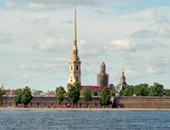
The Peter and Paul Fortress was founded by Peter the Great in 1703 to protect the lands along the Neva River from possible attacks by the Swedish army and navy. All the construction work on the fortress was carried out under the close supervision of St. Petersburg’s first architect Domenico Trezzini and the Tsar himself. The Swedes were defeated before the fortress was completed, and from 1721 the fortress served as a political jail. Among the first inmates was Peter’s own rebellious son Alexei. Parts of the former jail are now open to the public.
In the middle of the fortress there is the Peter and Paul Cathedral which serves as a burial vault of all the Russian Emperors. The Cathedral was the first church in the city built of stone. It is the highest building in St Petersburg (more than 120 meters). On top of the gilded spire of the Cathedral there is the figure of an angel holding a cross which is one of the most popular symbols of St Petersburg. Other buildings in the fortress house the City History Museum and the Mint, the Printing Workshop and the Museum of Space Explorations.
Day 2. St. Petersburg
Breakfast at the hotel.
Excursion to Mikhailovsky Castle.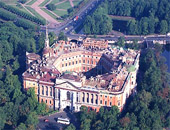
Mikhailovsky (St. Michael’s) Castle was built between 1797 and 1801 for Emperor Pavel I who wanted a castle where he could hide from his numerous enemies and ill-wishers. Therefore, the castle was surrounded from four sides by waters of the Moika River, the Fontanka River and two canals. Architects Vasily Bazhenov and Vincenzo Brenna constructed an architectural fantasy on the theme of a Middle Ages castle. Carlo Rastrelli’s memorial to Peter I was erected in front of the palace’s main façade in 1800.
Emperor Paul I spent only 40 nights in the castle. During the night of the 12th of March 1801 he was murdered in his own bedroom by a group of officers. Following the death of Pavel I, the Primary Engineers’ College was located here, hence the second name of the castle - Engineers' Castle.
Today the Castle is a branch of the Russian Museum and houses several permanent exhibitions. An exhibition of formal court portraits is on display. This is the first attempt to create a national portrait gallery in Russia. The basis of the exhibition is made up of representative portraits of Russian monarchs from Peter I to Nicolas II.
Day 3. St. Petersburg
Breakfast at the hotel.
Excursion to the Winter Palace.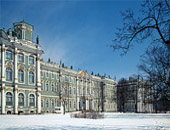
The Winter Palace is the largest building of the State Hermitage museum ensemble. In 1753 Saint Petersburg celebrated its 50th anniversary. To mark the event, Elizaveta Petrovna, the daughter of Peter the Great commissioned the construction of the Winter Palace to become the official royal residence. The magnificent green, white and gold palace was built in Baroque style after the design of the outstanding architect Francesco Bartholomeo Rastrelli.
The Winter Palace was completed in 1762 and remained the official royal residence of the Russian Emperors till 1917 when the ruling dynasty of Romanovs was dethroned.
Today, the Winter Palace and several adjacent buildings belong to the State Hermitage, one of the world’s greatest museums that has grown from a small collection of paintings, started by Catherine the Great in 1764, to a fantastic display of over 3 million exhibits dating from prehistoric to modern times.
Day 4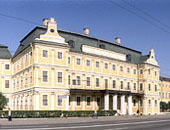 . St. Petersburg . St. Petersburg
Breakfast at the hotel.
Excursion to the Menshikov Palace.
The Menshikov Palace was one of the first stone building in Saint Petersburg constructed during 1710 - 1721 after the design of Giovanni Fontana and under the guidance of Johann Schaedel. The palace was the residence of Alexander Menshikov, the first Governor General of St Petersburg. It was the most luxurious building in St Petersburg of that time. Original fragments of the palace, like the famous Dutch tiles, have been well preserved and can still be admired today.
Day 5. 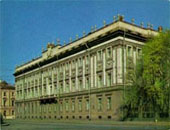 St. Petersburg St. Petersburg
Breakfast at the hotel.
Excursion to the Marble Palace.
The Marble palace is a vivid memorial to architecture of the early classicism. It was built during 1768 – 1785 after the design of the architect Antonio Rinaldi. Over 30 types of marble and granite were used for the exterior and interior decoration of the palace, hence its name - the Marble Palace. In the outer court there is an equestrian statue of Alexander III sculptured by Paolo Trubetskoy. The museum features several diverse collections like "Foreign Artists in Russia" (18th and 19th centuries) and "Peter Ludwig in the Russian Museum" (20th century).
Day 6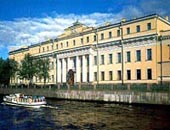 . St. Petersburg . St. Petersburg
Breakfast at the hotel.
Excursion to the Yusupov Palace.
Since the 18th century, the Yusupov Palace on the embankment of the Moyka River was the residence of the wealthy Yusupov family. The elegant interior of the palace still reflects the refined taste and cultural values of its former owners. It was in the Yusupov Palace where on the night of December 16 -17, 1916 the Tsar’s favorite, Grigory Rasputin, a peasant with supernatural powers, was killed. The organizer and participant of the conspiracy was the last owner of the palace Felix
Jusupov.
Day 7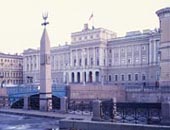 . St. Petersburg . St. Petersburg
Breakfast at the hotel.
Excursion to the Mariinski Palace.
The Mariinsky Palace was built in the middle of the XIX century on the square across the St Isaac’s Cathedral for the Grand Duchess Maria, daughter of Nicholas I. In 1884 the Mariinsky Palace was bought by the government and became the seat of the State Council, the State Chancellor and the Committee of Ministers (later the Council of Ministers). Since 1945 the palace belongs to the city council and local administration and is now the seat of the local Legislative Assembly.
Day 8. St. Petersburg
Breakfast at the hotel.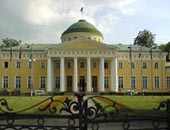
Excursion to the Tavrichesky (Taurida) Palace.
The palace was presented by Catherine II to Prince Gregory Potemkin (Potyomkin-Tavrichesky) who received the title of Prince of Taurida for his successful military operation during the conquest of Taurida (as the Crimea was called at that time). Catherine the Great wanted to introduce more dignified styles of architecture. After having studied engravings of classical architecture and new European buildings, she made classicism the official court style. Therefore the palace was built in the
style of the 18th century classicism with symmetrical rows of columns. The Palace was reconstructed at the beginning of the 20th century. Now it serves as headquarters for the InterParliamentary Assembly of the Commonwealth of Independent States.
Day 9. St. Petersburg
Breakfast at the hotel.
Free time. Transfer to the airport. Departure.
| 
